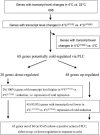The cold-induced early activation of phospholipase C and D pathways determines the response of two distinct clusters of genes in Arabidopsis cell suspensions
- PMID: 16258011
- PMCID: PMC1283760
- DOI: 10.1104/pp.105.068171
The cold-induced early activation of phospholipase C and D pathways determines the response of two distinct clusters of genes in Arabidopsis cell suspensions
Abstract
In plants, a temperature downshift represents a major stress that will lead to the induction or repression of many genes. Therefore, the cold signal has to be perceived and transmitted to the nucleus. In response to a cold exposure, we have shown that the phospholipase D (PLD) and the phospholipase C (PLC)/diacylglycerol kinase pathways are simultaneously activated. The role of these pathways in the cold response has been investigated by analyzing the transcriptome of cold-treated Arabidopsis (Arabidopsis thaliana) suspension cells in the presence of U73122 or ethanol, inhibitors of the PLC/diacylglycerol kinase pathway and of the phosphatidic acid produced by PLD, respectively. This approach showed that the expression of many genes was modified by the cold response in the presence of such agents. The cold responses of most of the genes were repressed, thus correlating with the inhibitory effect of U73122 or ethanol. We were thus able to identify 58 genes that were regulated by temperature downshift via PLC activity and 87 genes regulated by temperature downshift via PLD-produced phosphatidic acid. Interestingly, each inhibitor appeared to affect different cold response genes. These results support the idea that both the PLC and PLD pathways are upstream of two different signaling pathways that lead to the activation of the cold response. The connection of these pathways with the CBF pathway, currently the most understood genetic system playing a role in cold acclimation, is discussed.
Figures








References
-
- Baker SS, Wilhelm KS, Thomashow MF (1994) The 5′-region of Arabidopsis thaliana cor15a has cis-acting elements that confer cold-, drought- and ABA-regulated gene expression. Plant Mol Biol 24: 701–713 - PubMed
Publication types
MeSH terms
Substances
LinkOut - more resources
Full Text Sources
Other Literature Sources
Molecular Biology Databases

